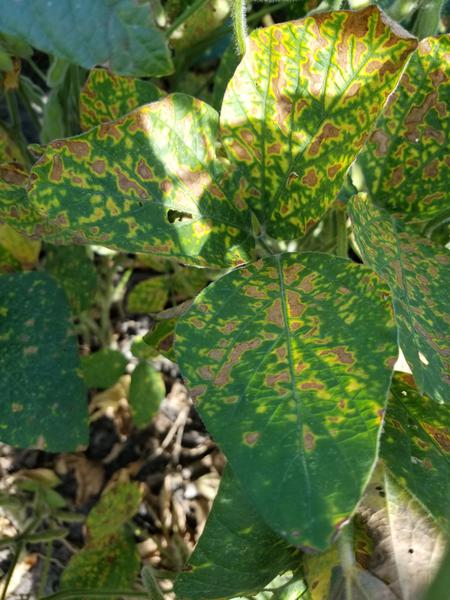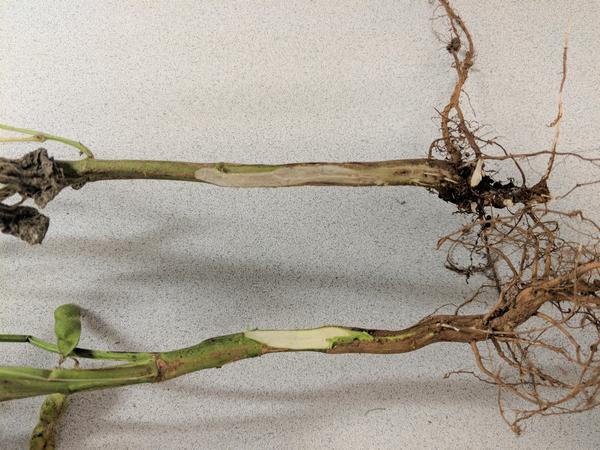Introduction
Fusarium wilt is a disease complex caused by several soil-borne fungi, commonly Fusarium oxysporum. Fusarium wilt can be a major limiting factor to soybean production. Infection can occur at any growth stage, but more often at early vegetative and reproductive stages (V3 and R1). In the United States, the disease can be found affecting soybean across all major soybean producing states, but it is more severe in northern than southern states. Although it has been reported affecting soybean in North Carolina, it usually does not represent a major threat to soybean production in the state.
Pathogen
Fusarium oxysporum is an ascomycete fungus found commonly in the soil. In culture, F. oxysporum produce white to pink, purple, or red colonies. In plant stems, the fungus may produce a purple to pink vascular discoloration. F. oxysporum produces different spore types that facilitate spread (microconidia and macroconidia), as well as serve as overwintering structures (chlamydospores).
Host Range
F. oxysporum has a broad host range and it have been reported affecting 150 plant species including tobacco, cotton, peanut, and other economically important rotational crops. Additionally, weeds can serve as alternative hosts, while remaining asymptomatic.
Life Cycle and Favorable Conditions for Disease
Chlamydospores serve as the survival structures for the fungus and reside in the soil or in crop debris from previous growing seasons. Spores germinate and fungal structures (hyphae) enter the roots and colonize the vascular tissue, impeding nutrient and water uptake. The fungus generates new conidia and chlamydospores as it invades plant tissues. As the root and stem tissues begin to decay, spores re-enter the soil to overwinter. Conditions that favor slow plant growth early in the growing season (e.g. cool, wet weather) favor disease development. Fusarium wilt is also commonly associated with other root injuries, like those caused by nematodes.
Symptoms and Signs
Fusarium wilt often occurs in irregular patches in the field (Figure 1). Symptoms are often first observed in hot and dry conditions when plants struggle to take up water. Foliar symptoms include interveinal chlorosis, premature defoliation and wilting (Figure 2). The roots often decay with brown to black epidermal tissues and reddish to brown vascular discoloration extending into the stem (Figure 3).
Management
Planting during optimal germination conditions for soybean emergence is important to limiting early infections by Fusarium species. Seed treatments may be used to limit early season infections. More information about fungicide efficacy can be found on the NC State Extension Soybean portal. Because nematodes can cause root injuries that allow Fusarium wilt severity to increase, limiting nematode injuries to soybean plants can also reduce disease incidence.
Useful Resources
The NC State University Plant Disease and Insect Clinic provides diagnostics and control recommendations.
The NC State Extension Plant Pathology portal provides information on crop disease management.
The Soybean Production Guide has descriptions of diseases and controls, updated annually.
The North Carolina Agricutural Chemicals Manual produced by NC State University has a more up-to-date list of chemicals available for disease control.
Acknowledgements
This factsheet was prepared by the NC State University Field Crops and Tobacco Pathology Lab in 2020.
- Check out our Facebook and our Twitter!
Publication date: Sept. 4, 2020
N.C. Cooperative Extension prohibits discrimination and harassment regardless of age, color, disability, family and marital status, gender identity, national origin, political beliefs, race, religion, sex (including pregnancy), sexual orientation and veteran status.
NC Cooperative Extension prohíbe la discriminación por raza, color, nacionalidad, edad, sexo (incluyendo el embarazo), discapacidad, religión, orientación sexual, identidad de género, información genética, afiliación política, y estatus de veteran.
The use of brand names in this publication does not imply endorsement by NC State University or N.C. A&T State University of the products or services named nor discrimination against similar products or services not mentioned.
Recommendations for the use of agricultural chemicals are included in this publication as a convenience to the reader. The use of brand names and any mention or listing of commercial products or services in this publication does not imply endorsement by NC State University or N.C. A&T State University nor discrimination against similar products or services not mentioned. Individuals who use agricultural chemicals are responsible for ensuring that the intended use complies with current regulations and conforms to the product label. Be sure to obtain current information about usage regulations and examine a current product label before applying any chemical. For assistance, contact your local N.C. Cooperative Extension county center.
N.C. Cooperative Extension prohibits discrimination and harassment regardless of age, color, disability, family and marital status, gender identity, national origin, political beliefs, race, religion, sex (including pregnancy), sexual orientation and veteran status.



